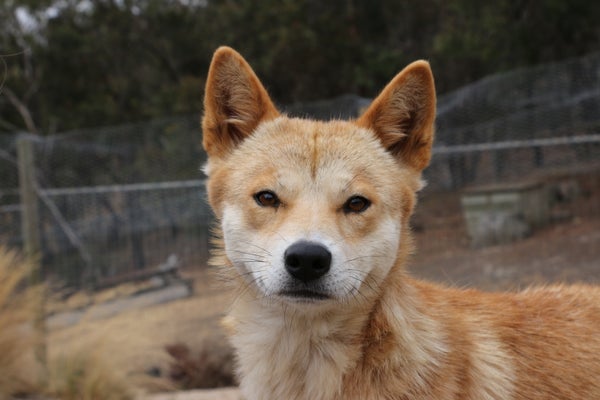When a dog gazes deeply into the eyes of its human, a powerful bond forms. The extended eye contact triggers the same hormone response that helps human mothers bond with their babies. As the dog stares, the hormone oxytocin floods the owner’s brain, causing him or her to lavish attention on the canine, which experiences a similar spike in the hormone and proceeds to stare even harder—and on it goes in a seemingly endless loop of love.
Yet behind those puppy-dog eyes are millennia of evolution at work. New research on dingoes—distinct descendants of the common ancestor of wolves and dogs—suggests the lengthy looks dogs and their owners share came about in phases. Dog ancestors began making quick eye contact with humans relatively early on in domestication, but the tendency to hold those bond-building gazes is a more recent development, scientists reported in October in Animal Behaviour.
Between 20,000 and 40,000 years ago some ancient canines began hanging around human settlements, living alongside the inhabitants and breeding, according to Kylie Cairns, a molecular ecologist at the University of New South Wales who was not part of the study. Then around 9,000 years ago a group of these partially tamed pooches set sail with their companions for Australia, where they eventually made their way back into the wild. It was only after these dingoes had gone feral that humans began actively breeding their canine relatives into today’s collies, greyhounds and poodles. “That means dingoes are giving us a snapshot of what proto-dogs were like before any human breeding,” says Angie Johnston, a doctoral student of psychology at Yale University who led the study.
On supporting science journalism
If you're enjoying this article, consider supporting our award-winning journalism by subscribing. By purchasing a subscription you are helping to ensure the future of impactful stories about the discoveries and ideas shaping our world today.
Wolves, unlike dingoes, have always kept their distance from humans. Researchers had previously tested whether eye contact between hand-reared wolves and their owners would elicit the same response as it does with dogs. They compared the two species by placing members of each in a room with their respective owners and recording the pairs’ interactions—talking, petting and staring—for 30 minutes. Before and after each session the researchers collected urine from both the humans and canines to measure oxytocin levels. Wolves, it turned out, almost never looked into their owners’ eyes—and even when they did, that eye contact failed to initiate an oxytocin feedback loop.
In the new study Johnston and her colleagues observed dingoes living at a sanctuary near Melbourne as they interacted with human handlers in a set up similar to that in the dog and wolf experiment. They found the dingoes’ behavior fell somewhere between that of the dogs and wolves. Unlike the wolves, nearly all of the dingoes made semisustained eye contact with their handlers. But unlike the dogs, with their lingering stares, the dingoes only stole short glances. “This suggests that even in the early stages of domestication, canids [the family that includes dogs, wolves and dingoes] may have already started making eye contact with humans, but it wasn’t until later that dogs started gazing into their owners’ eyes,” Johnston says.
Takefumi Kikusui, a behavioral scientist at Azabu University in Japan who led the earlier study on dogs and wolves but was not involved in the new research, says the dingo data elucidate the steps that led to dogs and humans bonding through mutual eye contact. The motivation behind the dingoes’ hurried glances, however, remains a mystery. “One possibility is that short-term eye contact is used as a social reference in observing the human’s behavior, while maintaining eye contact is related to manipulating the human’s behavior when asking for help,” Kikusui says. Wolves, he notes, do not tend to seek help from humans whereas dogs readily do so.
The longer staring bouts of dogs, which lasted an average of 40 seconds (compared with just three seconds for dingoes and less than a second for wolves), may be required to kick-start the oxytocin response in humans, Kikusui adds. Although the dingo study did not measure the brain chemical, Johnston suspects the quick glances between dingoes and their handlers—like the ones those proto-dogs probably began sharing with people thousands of years ago—were not quite as potent as the extended gazes that eventually solidified the bond between dogs and humans.
